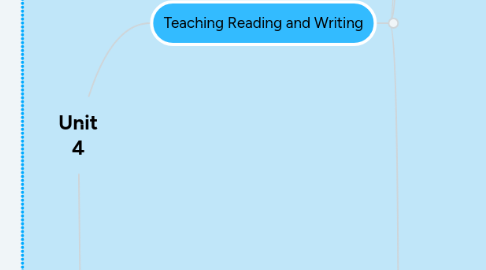
1. Teaching Reading and Writing
1.1. READING
1.1.1. Is a process of relating written symbols to oral language, constructing meaning from written text or "making sense and deriving meaning from the printed word".
1.1.1.1. To be able to read a child has to
1.1.1.1.1. Understand the alphabet
1.1.1.1.2. Decode
1.1.1.1.3. Develop sight vocabulay to read fluently
1.1.1.1.4. Develop strategies to help with comprehension and fluency
1.1.1.1.5. Read text that match her/his reading level and interests
1.1.1.1.6. Engage in extensive reading
1.2. Approches to teaching Reading
1.2.1. When we read we active two types of knoledge
1.2.1.1. TOP-DOWN
1.2.1.2. BOTTON-UP
1.2.2. Three approches should be considered for young learners
1.2.2.1. PHONICS
1.2.2.1.1. Is a botton-up approach
1.2.2.1.2. It focuses on the letters
1.2.2.1.3. It teaches the relationship between sound and letters
1.2.2.1.4. Help children decode written language using the sound-symbol relationship
1.2.2.2. Best practices in teaching reading
1.2.2.2.1. Guidance of developing children's speaking and listening skills
1.2.2.2.2. Direct teaching of phonics as a primary means of teaching decoding and encoding
1.2.2.2.3. A broad and language - rich curriculum
1.2.2.3. Phonemic awareness activities
1.2.2.3.1. Help children
1.2.2.3.2. Activities
1.2.2.4. Phonics activities
1.2.2.4.1. Focuse on written language
1.2.2.4.2. Activities
1.2.2.5. Activities
1.2.2.5.1. Reading aloud
1.2.2.5.2. Shared reading
1.2.2.5.3. Guided reading
1.2.2.5.4. Independent reading
1.2.2.6. LANGUAGE EXPERIENCE
1.2.2.6.1. Is a top-down approach
1.2.2.6.2. Use learner's oral language as the basis of written stories
1.2.2.6.3. YL follow these steps
1.2.3. WHOLE LANGUAGE
1.2.3.1. Is a top-down processing
1.2.3.2. Begins with meaning
1.2.3.3. Uses language in context for further word or language study
1.2.3.4. Children bring their
1.2.3.4.1. Knowledge
1.2.3.4.2. Experience
1.2.3.5. Constructing comprehension of written texts
1.2.3.6. Use clues
1.2.3.6.1. Grapho-phonemic
1.2.3.6.2. Semantic
1.2.3.6.3. Syntactic
1.2.3.6.4. Pragmatic
1.2.3.7. Focus on common words
1.2.3.7.1. "Sight words"
1.2.4. Effective reading activities
1.2.4.1. Activities for beggining readers
1.2.4.1.1. Pointing to or circling words
1.2.4.1.2. Sorting or labelling pictures
1.2.4.1.3. Completing words
1.2.4.1.4. Playing games
1.2.4.1.5. Filling in
1.2.4.1.6. Creating words, collages
1.2.4.2. Activities for advanced readers
1.2.4.2.1. Unscrumbling words
1.2.4.2.2. Multiple choice
1.2.4.2.3. Sccaning or Writing text
1.2.4.2.4. Correcting mistakes
1.2.4.2.5. Taking notes in a graphic organizer
1.2.4.3. Pre - During - Post - reading activities
1.2.4.3.1. Pre - reading
1.2.4.3.2. During - reading
1.2.4.3.3. Post - reading
1.2.4.4. Reading Strategies
1.2.4.4.1. Predicting
1.2.4.4.2. Monitoring
1.2.4.4.3. Confirming
1.2.4.4.4. Connecting
1.2.4.4.5. Skimming / Scannig
1.2.4.4.6. Distinguishing
1.2.4.4.7. Using context clues
1.2.4.4.8. Paraphrasing or summarizing
1.2.4.4.9. Visualizing
1.3. WRITING
1.3.1. Writing assigment have a specific (FAT -P)
1.3.1.1. Form
1.3.1.2. Audience
1.3.1.3. Topic
1.3.1.4. Purpose
1.3.2. Is the most neglected skill in EYL
1.3.2.1. We write to
1.3.2.1.1. Communicate ideas
1.3.2.1.2. Interact socially with others
1.3.2.1.3. To get information and learn
1.3.2.2. For children means
1.3.2.2.1. Self - expression
1.3.2.2.2. Focus on meaning
1.3.2.2.3. Reforcing oral language development
1.3.3. Approches to teaching Writting
1.3.3.1. Children learning to write go through a number of stages
1.3.3.1.1. Drawing
1.3.3.1.2. Scribbling
1.3.3.1.3. Tracing
1.3.3.1.4. Writing letters
1.3.3.2. Use their "intellectual and linguistic resources"
1.3.3.3. The goal is YL
1.3.3.3.1. Construct original texts
1.3.3.4. Two mayor approaches to considered for young learners
1.3.3.4.1. A PRODUCT - BASED APPROACH
1.3.3.4.2. Controlled and guided activities
1.3.3.4.3. A PROCESS - BASED APPROACH
1.3.3.4.4. Writing workshop
1.3.3.4.5. Texts for writting
2. READING AND WRITING DIGITAL TEXTS
2.1. E - PALS AND PAIRED CLASSES
2.1.1. A modern adaptation of pen pals
2.1.2. Have a common topic
2.1.3. Writing to each other regularly
2.2. PHOTO - AUTOBIOGRAPHIES
2.2.1. Use digital cameras
2.2.2. Take pictures about thinks are significant to them
2.2.3. Develop small digital book
